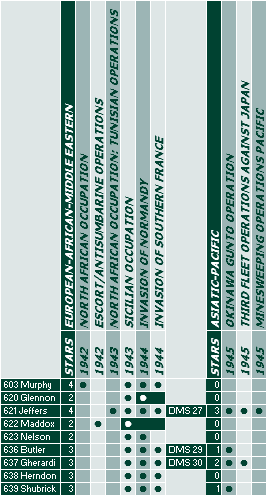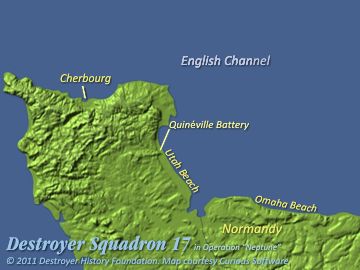
World War II operations of destroyers
originally attached to Squadron 17

For two years, convoy escort assignments were standard fare—typically across the Atlantic but also to other destinations such as Panama. As invasions loomed, these were interrupted by rehearsals, followed in the event by shore bombardments and night offensive sweeps to protect troop transports, always with a prospect of anti-air and anti-submarine action.
Murphy joined the Atlantic Fleet in 1942 in time for the invasion of North Aftrica. On 7 November, she and Ludlow were hit by shore battery fire off Fedhala (Mohammedia), Morocco. Murphy lost three men killed and 25 wounded but remained on station.
The squadron was at full strength for the invasion of Sicily in July 1943, screening cruisers Boise and Savannah in RAdm. J. L. Hall’s “Dime” Task Force 81, with McLanahan attached from DesRon 16. En route, off Bizerte, Tunisia on the 6th, Jeffers shot down a German bomber.
On station off Gela before sunrise on D-day, the 10th, Maddox was lost to an underwater explosion from a near miss by a German bomber.
Following forces ashore around to Sicily’s north coast, Shubrick got under way from Palermo Harbor before dawn on 14 August screening Savannah when a bomber dropped three bombs—one hit and two near misses—which nearly sank her.
On 21 October, 70 miles off New Jersey’s Manasquan Inlet en route to Europe, the tanker Bulkoil rammed Murphy, cutting off her bow. Murphy’s stern was towed to New York, where a new bow was fitted.

DesRon 17 at Normandy, June 1944.
Murphy rejoined the squadron for the invasion of Normandy in June 1944, where DesDiv 34 operated with DesDiv 20 as Fire Support Group “U” off Utah Beach and DesDiv 33, with Plunkett, was attached to a Reserve Fire Support Group. No DesRon 17 ships were hit on D-day, 6 June, but off the Quinéville Battery on the 8th, Glennon struck a mine and was lost. On the 13th, Nelson was torpedoed by a German S-boat and lost her stern.
In August, the six destroyers still in the war zone, Butler, Gherardi, Herndon, Jeffers, Murphy and Shubrick, moved to the Mediterranean for the invasion of southern France, where they were attached to RAdm T. C. Durgin's Task Group 88.2 with antiaircraft cruisers HMS Colombo and Caledon, screening an Aircraft Carrier Force.
Later in 1944, Jeffers, Butler and Gherardi were converted as fast minesweepers. Attached to Mine Squadron 20, they went to Okinawa, where Jeffers and Butler were damaged by suicide planes crashing close aboard. Butler was towed home and decommissioned but Jeffers continued in the war. In August 1945, she and Gherardi swept the entrance to Tokyo Bay prior to the arrival of the Third Fleet.
On 11 February 1945, meanwhile, Murphy sailed through the Suez Canal to Jidda, Arabia (Jeddah, Saudi Arabia), where King Ibn Saud of Saudi Arabia and his party boarded for transportation to Great Bitter Lake, Egypt, for a conference with President Roosevelt. Later in 1945, Murphy and the other ships of the squadron moved to the Pacific.
Reassigned to DesDiv 12, Herndon and Shubrick went to Okinawa, where Shubrick was knocked out of action and not repaired. Based at Eniwetok in the Marshall Islands from July, Herndon escorted convoys through the end of the war and then went to China, where she received the surrender of Japanese naval and merchant vessels in the Tsingtao area.
Nelson also made it to the Pacific. After repairs from Normandy, she screened escort carrier Card in the Atlantic and then transited to the Pacific on 1 August, arriving at Tokyo Bay after the surrender.
Sources: Destroyer History Foundation database, Roscoe, Morison, Dictionary of American Naval Fighting Ships entries for individual ships.